
Cardiac Arrest; The Faster You Act, The Better

image: Parkview Health
If you or someone you know is feeling tightness, pressure, heaviness or squeezing across your chest, it is time to call an ambulance immediately. Often the pain starts spreading toward your arms, mostly toward the left arm, neck, jaw, tummy, back coupled with sweating, shortness of breath, nausea, lightheadedness, vomiting, wheezing or coughing. They are all symptoms of a heart attack and must be dealt with immediately.
In most cases, the pain in chest is severe, however, some people only experience minor pain. Chest pain is the most common symptom of a cardiac arrest in men and women, however, women also experience pain in back and jaw, shortness of breath and nausea along with it.
There are some other signs and symptoms that indicate that a person is suffering from a cardiac arrest including: the patient may stop moving and they stop responding to touch and any other simulation.
In case someone is showing these symptoms and you do not have any access to an automated external defibrillator (AED), start doing chest compressions until the help arrives.
How To Do Chest Compressions:
For an adult, put the heel of your hand on the breastbone of the patient. Now put your other hand on the top of the first hand and interlock the fingers. Use your whole bodyweight and start pressing down on their chest. Keep doing this until an ambulance is there. You should be doing 100-120 compressions per minute.
You can also find the “hands-only” CPR tutorial from the British Heart Foundation helpful in this situation .
Heart attacks are becoming more common in young people and only timely response can save a person’s life in this situation.







